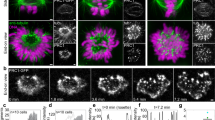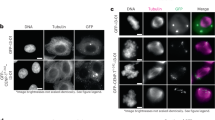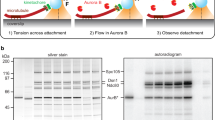Abstract
The movement of sister chromatids to opposite spindle poles during anaphase depends on the prior capture of sister kinetochores by microtubules with opposing orientations (amphitelic attachment or bi-orientation)1. In addition to proteins necessary for the kinetochore–microtubule attachment, bi-orientation requires the Ipl1 (Aurora B in animal cells) protein kinase2,3,4,5,6,7 and tethering of sister chromatids by cohesin8,9. Syntelic attachments, in which sister kinetochores attach to microtubules with the same orientation, must be either ‘avoided’ or ‘corrected’. Avoidance might be facilitated by the juxtaposition of sister kinetochores such that they face in opposite directions; kinetochore geometry is therefore deemed important. Error correction, by contrast, is thought to stem from the stabilization of kinetochore–spindle pole connections by tension in microtubules, kinetochores, or the surrounding chromatin arising from amphitelic but not syntelic attachment10,11. The tension model predicts that any type of connection between two kinetochores suffices for efficient bi-orientation. Here we show that the two kinetochores of engineered, unreplicated dicentric chromosomes in Saccharomyces cerevisiae bi-orient efficiently, implying that sister kinetochore geometry is dispensable for bi-orientation. We also show that Ipl1 facilitates bi-orientation by promoting the turnover of kinetochore–spindle pole connections in a tension-dependent manner.
This is a preview of subscription content, access via your institution
Access options
Subscribe to this journal
Receive 51 print issues and online access
$199.00 per year
only $3.90 per issue
Buy this article
- Purchase on Springer Link
- Instant access to full article PDF
Prices may be subject to local taxes which are calculated during checkout




Similar content being viewed by others
References
Tanaka, T. U. Bi-orienting chromosomes on the mitotic spindle. Curr. Opin. Cell Biol. 14, 365–371 (2002)
Biggins, S. et al. The conserved protein kinase Ipl1 regulates microtubule binding to kinetochores in budding yeast. Genes Dev. 13, 532–544 (1999)
He, X., Rines, D. R., Espelin, C. W. & Sorger, P. K. Molecular analysis of kinetochore–microtubule attachment in budding yeast. Cell 106, 195–206 (2001)
Adams, R. R., Maiato, H., Earnshaw, W. C. & Carmena, M. Essential roles of Drosophila inner centromere protein (INCENP) and aurora B in histone H3 phosphorylation, metaphase chromosome alignment, kinetochore disjunction, and chromosome segregation. J. Cell Biol. 153, 865–880 (2001)
Kaitna, S., Pasierbek, P., Jantsch, M., Loidl, J. & Glotzer, M. The aurora B kinase AIR-2 regulates kinetochores during mitosis and is required for separation of homologous chromosomes during meiosis. Curr. Biol. 12, 798–812 (2002)
Tanaka, T. U. et al. Evidence that the Ipl1–Sli15 (Aurora kinase–INCENP) complex promotes chromosome bi-orientation by altering kinetochore–spindle pole connections. Cell 108, 317–329 (2002)
Hauf, S. et al. The small molecule Hesperadin reveals a role for Aurora B in correcting kinetochore–microtubule attachment and in maintaining the spindle assembly checkpoint. J. Cell Biol. 161, 281–294 (2003)
Tanaka, T., Fuchs, J., Loidl, J. & Nasmyth, K. Cohesin ensures bipolar attachment of microtubules to sister centromeres and resists their precocious separation. Nature Cell Biol. 2, 492–499 (2000)
Sonoda, E. et al. Scc1/Rad21/Mcd1 is required for sister chromatid cohesion and kinetochore function in vertebrate cells. Dev. Cell 1, 759–770 (2001)
Nicklas, R. B. & Koch, C. A. Chromosome micromanipulation. III. Spindle fiber tension and the reorientation of mal-oriented chromosomes. J. Cell Biol. 43, 40–50 (1969)
Nicklas, R. B. How cells get the right chromosomes. Science 275, 632–637 (1997)
Winey, M. et al. Three-dimensional ultrastructural analysis of the Saccharomyces cerevisiae mitotic spindle. J. Cell Biol. 129, 1601–1615 (1995)
Hegemann, J. H. & Fleig, U. N. The centromere of budding yeast. BioEssays 15, 451–460 (1993)
Hill, A. & Bloom, K. Genetic manipulation of centromere function. Mol. Cell. Biol. 7, 2397–2405 (1987)
Goshima, G. & Yanagida, M. Establishing biorientation occurs with precocious separation of the sister kinetochores, but not the arms, in the early spindle of budding yeast. Cell 100, 619–633 (2000)
He, X., Asthana, S. & Sorger, P. K. Transient sister chromatid separation and elastic deformation of chromosomes during mitosis in budding yeast. Cell 101, 763–775 (2000)
Matsuzaki, H., Nakajima, R., Nishiyama, J., Araki, H. & Oshima, Y. Chromosome engineering in Saccharomyces cerevisiae by using a site-specific recombination system of a yeast plasmid. J. Bacteriol. 172, 610–618 (1990)
Michaelis, C., Ciosk, R. & Nasmyth, K. Cohesins: chromosomal proteins that prevent premature separation of sister chromatids. Cell 91, 35–45 (1997)
Guacci, V., Hogan, E. & Koshland, D. Chromosome condensation and sister chromatid pairing in budding yeast. J. Cell Biol. 125, 517–530 (1994)
Thrower, D. A. & Bloom, K. Dicentric chromosome stretching during anaphase reveals roles of Sir2/Ku in chromatin compaction in budding yeast. Mol. Biol. Cell 12, 2800–2812 (2001)
DiNardo, S., Voelkel, K. & Sternglanz, R. DNA topoisomerase II mutant of Saccharomyces cerevisiae: topoisomerase II is required for segregation of daughter molecules at the termination of DNA replication. Proc. Natl Acad. Sci. USA 81, 2616–2620 (1984)
Holm, C., Goto, T., Wang, J. C. & Botstein, D. DNA topoisomerase II is required at the time of mitosis in yeast. Cell 41, 553–563 (1985)
Uemura, T. et al. DNA topoisomerase II is required for condensation and separation of mitotic chromosomes in S. pombe. Cell 50, 917–925 (1987)
Vagnarelli, P. et al. Analysis of Scc1-deficient cells defines a key metaphase role of vertebrate cohesin in linking sister kinetochores. EMBO Rep. 5, 167–171 (2004)
Kim, J. H., Kang, J. S. & Chan, C. S. Sli15 associates with the Ipl1 protein kinase to promote proper chromosome segregation in Saccharomyces cerevisiae. J. Cell Biol. 145, 1381–1394 (1999)
Kaitna, S., Mendoza, M., Jantsch-Plunger, V. & Glotzer, M. INCENP and an Aurora-like kinase form a complex essential for chromosome segregation and efficient completion of cytokinesis. Curr. Biol. 10, 1172–1181 (2000)
Adams, R. R. et al. INCENP binds the Aurora-related kinase AIRK2 and is required to target it to chromosomes, the central spindle and cleavage furrow. Curr. Biol. 10, 1075–1078 (2000)
Cheeseman, I. M. et al. Phospho-regulation of kinetochore–microtubule attachments by the Aurora kinase Ipl1p. Cell 111, 163–172 (2002)
Losada, A., Hirano, M. & Hirano, T. Cohesin release is required for sister chromatid resolution, but not for condensin-mediated compaction, at the onset of mitosis. Genes Dev. 16, 3004–3016 (2002)
Cimini, D. et al. Merotelic kinetochore orientation is a major mechanism of aneuploidy in mitotic mammalian tissue cells. J. Cell Biol. 153, 517–527 (2001)
Tanaka, T., Cosma, M. P., Wirth, K. & Nasmyth, K. Identification of cohesin association sites at centromeres and along chromosome arms. Cell 98, 847–858 (1999)
Acknowledgements
We thank A. Toth for discussions leading to the use of unreplicated dicentric chromosomes; W. Earnshaw for discussing inhibition of Top2 in Scc1-depleted cells and for sharing unpublished data; M. J. R. Stark and J. Swedlow for discussion and critically reading the manuscript; N. Mukae and C. Newlon for discussion; P. Andrews and S. Swift for help with time-lapse microscopy; and R. Ciosk, S. Biggins, F. Uhlmann, X. He, P. Sorger, R. Tsien, W. Fangman, H. Araki, C. Holm, R. Sternglanz, C. Chan and EUROSCARF for reagents. This work was supported by The Wellcome Trust, Cancer Research UK, EMBO Young Investigator Program, and a fellowship (to K.T.) from Japan Society for the Promotion of Science.
Author information
Authors and Affiliations
Corresponding author
Ethics declarations
Competing interests
The authors declare that they have no competing financial interests.
Supplementary information
41586_2004_BFnature02328_MOESM2_ESM.pdf
Supplementary figure 1: Maintenance of minichromosomes when recombinase is expressed or when the second centromere (PGAL-CEN) is activated. (PDF 182 kb)
41586_2004_BFnature02328_MOESM3_ESM.pdf
Supplementary figure 2: Bi-orientation is established soon after SPB separation for an unreplicated dicentric minichromosome. (PDF 95 kb)
41586_2004_BFnature02328_MOESM5_ESM.pdf
Supplementary figure 4: Behaviour of unreplicated monocentric minichromosomes in IPL1+ and ipl1-321 nuclei with more than two SPBs. (PDF 63 kb)
Rights and permissions
About this article
Cite this article
Dewar, H., Tanaka, K., Nasmyth, K. et al. Tension between two kinetochores suffices for their bi-orientation on the mitotic spindle. Nature 428, 93–97 (2004). https://doi.org/10.1038/nature02328
Received:
Accepted:
Published:
Issue Date:
DOI: https://doi.org/10.1038/nature02328
This article is cited by
-
Recent advances in chromosome capture techniques unraveling 3D genome architecture in germ cells, health, and disease
Functional & Integrative Genomics (2023)
-
Tension can directly suppress Aurora B kinase-triggered release of kinetochore-microtubule attachments
Nature Communications (2022)
-
The bone marrow niche regulates redox and energy balance in MLL::AF9 leukemia stem cells
Leukemia (2022)
-
Accurate chromosome segregation by probabilistic self-organisation
BMC Biology (2015)
-
Three wise centromere functions: see no error, hear no break, speak no delay
EMBO reports (2013)
Comments
By submitting a comment you agree to abide by our Terms and Community Guidelines. If you find something abusive or that does not comply with our terms or guidelines please flag it as inappropriate.



